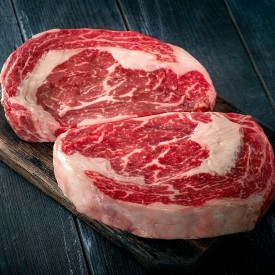- Price for 100g: 7.54 zł
- Origin: Argentina
Beef
(
111
pcs.)
Showing 1-12 of 111 item(s)
75.39 zł
Price for 100g:
7.54 zł
Our 100% Angus ground beef from Argentina is distinguished by its unique flavor profile, which is a result of proper cattle nutrition and traditional breeding methods. The meat contains an optimal amount of evenly...
14.10 zł
16.59 zł
- Price for 100g: 20.14 zł
- Origin: Poland
Price for 100g:
20.14 zł
Polish beef carpaccio is extremely tender, thinly sliced beef from the best domestic breeders. It delights with its exquisite and full flavor. Accompanied with arugula, freshly grated Parmesan, a touch of high-quality...
25.31 zł
- Price for 100g: 16.87 zł
- Origin: Spain
- Quality assurance: BIO
Price for 100g:
16.87 zł
Beef ribs steak BIO Spanish beef is an unusual but extremely flavorful rib cut also known as short ribs flanken style. This type of cut is loved in Argentina and Uruguay. "Asado de Tira" is an extremely tender and...
147.21 zł
- Price for 100g: 49.07 zł
- Origin: USA
- Quality assurance: USDA PRIME
Price for 100g:
49.07 zł
The USDA PRIME grade American ribeye steak is literally a delight for the palate. When it comes to American beef, this fantastic steak is definitely at the top of the podium. This steak is the showpiece of our store....
82.22 zł
- Price for 100g: 10.28 zł
- Origin: Poland
Price for 100g:
10.28 zł
Incredibly tender beef cheeks from noble Polish beef are perfect for braising and sous vide cooking techniques. Beef from this element is full of precious collagen thanks to its rich connective tissue content. In...
335.69 zł
- Price for 100g: 18.65 zł
- Origin: Poland
Price for 100g:
18.65 zł
Polish beef tenderloin has so many admirers for a reason. It is valued primarily for the exceptional tenderness and tenderness of its meat and for the excellent, natural taste of Polish native beef. In addition to...
347.87 zł
- Price for 100g: 24.85 zł
- Origin: USA
- Quality assurance: USDA CHOICE
Price for 100g:
24.85 zł
Picanha Black Angus USA is the best part from the leg muscle group for grilling and roasting. It is a beloved item in South America and is more expensive there than tenderloin. There is about a 1.5 cm layer of fat on...
1,034.78 zł
- Price for 100g: 14.78 zł
- Origin: USA
- Quality assurance: USDA CHOICE
Price for 100g:
14.78 zł
Black Angus USA beef brisket is the original American brisket made from premium quality beef. Such briskets are prepared in the States at BBQ competitions. In our store you can buy full brisket, that is, consisting of...
35.39 zł
- Price for 100g: 7.08 zł
- Origin: Poland
- Quality assurance: Quality Meat Program (QMP)
Price for 100g:
7.08 zł
Boneless beef shank from noble Polish beef is by far the best element for stew. We source it from young, fatty heifers. It is full of connective tissue and precious collagen that gives the meat its extraordinary...
554.61 zł
- Price for 100g: 18.49 zł
- Origin: Argentina
- Quality assurance: Argentine Quality Beef
Price for 100g:
18.49 zł
A true classic for meat connoisseurs and one of the most prized steak items. Striploin from Argentine Angus beef was obtained from cattle grazing in the vast pastures of the Pampas. This 100% natural cut of grass fed...
221.45 zł
- Price for 100g: 14.76 zł
- Origin: Poland
Price for 100g:
14.76 zł
Young heifer Picanha is one of our favorite cuts, both for steaks and for the low and slow technique. It's a delicious piece of rump. Highly popular and considered one of the best cuts of beef in South America. In...
114.66 zł
- Price for 100g: 7.64 zł
- Origin: Poland
- Quality assurance: Quality Meat Program (QMP)
Price for 100g:
7.64 zł
Beef shank with a long bone for BBQ, also known as Hammer Beef or "Thor's Hammer," as the name suggests, is not a toy for children. It's a true delicacy for pitmasters. The meat is lean and contains a lot of...












